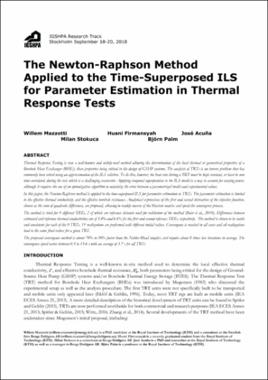| dc.contributor.author | Mazzotti, Willem | |
| dc.contributor.author | Firmansyah, Husni | |
| dc.contributor.author | Acuna, Jose | |
| dc.contributor.author | Stokuca, Milan | |
| dc.contributor.author | Palm, Bjorn | |
| dc.contributor.other | IGSHPA Research Track (2018) | |
| dc.date.accessioned | 2018-08-28T17:58:59Z | |
| dc.date.available | 2018-08-28T17:58:59Z | |
| dc.date.issued | 2018 | |
| dc.identifier | oksd_ighspa_2018_mazzotti_2 | |
| dc.identifier.uri | https://hdl.handle.net/11244/301578 | |
| dc.description.abstract | Thermal Response Testing is now a well-known and widely-used method allowing the determination of the local thermal or geometrical properties of a Borehole Heat Exchanger (BHE), those properties being critical in the design of GSHP systems. The analysis of TRTs is an inverse problem that has commonly been solved using an approximation of the ILS solution. To do this, however, the heat rate during a TRT must be kept constant, or least be non time-correlated, during the test, which is a challenging constraint. Applying temporal superposition to the ILS model is a way to account for varying power, although it requires the use of an optimization algorithm to minimize the error between a parametrized model and experimental values. | |
| dc.description.abstract | In this paper, the Newton-Raphson method is applied to the time-superposed ILS for parameter estimation in TRTs. The parameter estimation is limited to the effective thermal conductivity and the effective borehole resistance. Analytical expressions of the first and second derivatives of the objective function, chosen as the sum of quadratic differences, are proposed, allowing to readily inverse of the Hessian matrix and speed the convergence process. | |
| dc.description.abstract | The method is tried for 9 different TRTs, 2 of which are reference datasets used for validation of the method (Beier et al., 2010). Differences between estimated and reference thermal conductivities are of 3.4% and 0.4% for the first and second reference TRTs, respectively. The method is shown to be stable and consistent: for each of the 9 TRTs, 11 realizations are performed with different initial values. Convergence is reached in all cases and all realizations lead to the same final values for a given TRT. | |
| dc.description.abstract | The proposed convergence method is about 70% to 90% faster than the Nelder-Mead simplex and require about 8 times less iterations in average. The convergence speed varies between 0.3 to 13.6 s with an average of 3.7 s for all TRTs. | |
| dc.format | application/pdf | |
| dc.language | en_US | |
| dc.publisher | International Ground Source Heat Pump Association | |
| dc.rights | In the Oklahoma State University Library's institutional repository this paper is made available through the open access principles and the terms of agreement/consent between the author(s) and the publisher. The permission policy on the use, reproduction or distribution of the article falls under fair use for educational, scholarship, and research purposes. Contact Digital Resources and Discovery Services at lib-dls@okstate.edu or 405-744-9161 for further information. | |
| dc.title | Newton-Raphson method applied to the time-superposed ILS for parameter estimation in Thermal Response Tests | |
| osu.filename | oksd_ighspa_2018_mazzotti_2.pdf | |
| dc.identifier.doi | 10.22488/okstate.18.000039 | |
| dc.type.genre | Conference proceedings | |
| dc.type.material | Text | |
